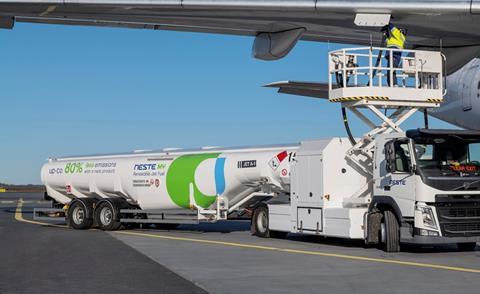President Joe Biden has proposed instituting tax credits for the production of both hydrogen fuel and sustainable aviation fuel (SAF), a move mirroring broader support from industry and lawmakers for aviation-related clean-fuel subsidies.
The tax credits contained in president Biden’s just-released 10-year budget proposal, which broadly lays out the president’s priorities.
The proposal calls for the US government to provide a tax credit starting at $1.50 per gallon for companies that produce SAF, also known as biofuel.

The credit, available from 2022 to 2027, would apply only to SAF that “achieves at least a 50% reduction in emissions relative to conventional jet fuel”, say budget documents.
The proposal would step up the credit for SAF that provides greater than 50% emission reduction, up to $1.75 per gallon for hydrogen fuel with “100% emissions reduction”.
SAF and other biofuels are produced from biomass like plants, which distinguishes them from fossil-based fuels. Burning biofuel releases carbon that had previously been absorbed from the atmosphere by plants, meaning their CO2 impact is “almost neutral”, according to IATA.
“Sustainable aviation fuel is beginning to enter the US market, but at a very slow pace,” budget documents say. “Providing incentives to spur the production of sustainable aviation fuel would deliver more feedstocks to sustainable aviation fuel production and help decarbonise the aviation industry.”
SAF is already eligible for a $1 per gallon tax credit, but that benefit expires in December.
Biden has proposed a $3 per kilogram of hydrogen produced between 2022 and 2024, declining to $2 per kilogram between 2025 and 2027, budget documents show.
The credit would apply to hydrogen produced for the purpose of being used in the energy, industrial, chemical and transportation industries.
Also, only “low-carbon hydrogen” would qualify for the credit, meaning it must be produced one of two ways. It could be made using water and zero-carbon emission electricity – meaning nuclear or renewable power, such as solar panels or wind turbines. Or, it could be produced from natural gas, so long as carbon emitted during production is “captured and sequestered”, documents say.
“The use of low-carbon hydrogen as a fuel source, an industrial feedstock or to produce and store electricity can play a critical role in accelerating the reduction of carbon emissions,” budget documents say.
Biden’s budget comes one week after a cadre of aerospace lobbying groups urged lawmakers to ensure aviation-related clean-energy technologies receive funding as part of a massive infrastructure bill working through Congress.
The groups called for SAF tax credits and funding for various other initiatives, including research into hydrogen fuel and electric propulsion.



















